49 ROAD SALT ADDICTION
By: Andrea Campos
Please note, although problems, information and names mentioned below are real, the story serving as the case scenario is fictional.
“There’s really no change,” ….. “The challenge with salt is it’s pretty much invisible. You put it down and it disappears. The more people that are aware there’s an environmental impact, the more people will think twice before demanding that level of service from their local store or municipality. Their behaviour impacts the health of the watershed. (Simon, 2017)”
Bill Thompson – Integrated watershed management manager
Lake Simcoe Region Conservation Authority
Barrie, ON. Apr 27, 2017
Temperatures were finally going up. This was a relief for most Canadians living in southern Ontario who had experienced severe weather this winter too many times for their liking. However, for Mike Walters – Chief Administrative Office for the Lake Simcoe region Conservation authority, this change in the weather could only mean one thing. He soon would need to face once more Craig Morton, the city of Barrie roads manager. This was a meeting he was not particularly eager to have, as it felt repetitive. It was almost like adéjà-vuof winning the battle but losing the war. Once again, the leadership team of the city of Barrie would get together to discuss and approve both budget and purchases for the annual “Winter road maintenance” program.
In the last years, during this meeting, the group had listened to Mike and his team’s presentation about the worrisome salinization indicators for the lake and its tributaries, and the potentially devastating consequences this situation could generate if immediate measures were not taken. Year after year, election after election, since the first scientific report was presented (Minister of Public Works and Government Service, 2001), leaders of the region – among them Barrie, Orillia and Infield mayors, had accepted the information. Yes, they were concerned; yes, they understood the problem. Each of them had asked their work units to develop policies to reduce road salts use. Yes, they were on the conservation authority’s side. However, Mike and his team could not help but think that what was being done was not enough. Although the amount of road salt per-determined area was slowly decreasing, the truth was that the chloride concentration in the Lake Simcoe watershed was annually increasing around 0.7 milligrams per litre since 1971 (Simon, 2017) (Lake Simcoe Region Conservation Authority , 2016). Effects on the local fauna and flora started to be seen, as the presence of the zebra mussels – invasive marine species (Lake Simcoe Region Conservation Authority, 2012 ), and negative impacts on insect populations at the lake’s tributaries.
Why were implemented actions not working? What should be done then? What points were the first ones to be addressed in the plan for upcoming winters? Would quick adjustments here and there help? Alternatively, would this be the scenario to propose a complete overhaul of the program and go for radical measures?
ROAD SALT USE
It is estimated that around 60 million metric tons of rock salt were employed worldwide in 2016. Main consumption was seen in North America and Europe, and at a much lower level in Asia and South America (Breining, 2017 ). In the United States, salt use on roads to melt ice and snow first started in 1940, using only 150 kilograms per year. Nowadays, US utilization of road salts is around 18 Million metric tons per year (Exhibit 1:), in 26 states – some using much more than others depending on winter severity.
The volume Canada uses varies from year to year depending on winter severity and frequency of major storms (Russell, 2017)., but the numbers in the last decade have been around five million tons per year (Summers & Valleau, 2019 )Toronto spends about 10 million dollars annually in about 140,000 tons (City of Toronto, n.d.), and the city of Montreal follows closely with around 130,000 tons per year. At the Simcoe county the use is calculated to be near to 46,000 tons per year, including in this volume what is used by the county plus what the province uses on highways in the area (Adams, 2019).
Aside from the constant increase in consumption as volume per year statistics show, it is also a lucrative mining business. Multinational companies like Cargill are leaders in the industry (Whitehouse, 2018 ). Due to the extreme weather experienced in the last decade, municipalities were forced to over-forecast their budget’s allowance for winter road maintenance. This increased demand made prices go up. Just in December 2018 prices in Canada were between CAD 140 and CAD 160 /ton, a significant rise from the previous year, when the price was between CAD 90 and CAD 110 /ton (Tumilty, 2018). Moreover, these prices were only for contracted volumes. If municipalities were forced to buy additional volumes outside the contracted ones, it became a seller’s game, and price per ton could be twice as much, depending on product availability.
NORTH AMERICA VS. EUROPE, WHY THE DISPARITY?
Europe uses about 8 million tons per year. The size of the land and the snowfall amount is comparable to that one in North America; however, when comparing the areas strongly impacted by winter, Europe has twice the population of North America. So why does North America use three times as much salt? Several reasons need to be considered. First, in Europe public transportation is prioritized over private vehicles. Thus, de-icing efforts are focused on clearing the railways and pathways that the majority of the population employs for mobility. In North America, it is the standard for each household to own several vehicles with one or two passengers per vehicle. Also, although municipalities like Barrie had made an effort to reduce the rate of use per squared area, the rapid population growth and physical expansion of cities seen in North America, has required the construction of new roads, and hence, the addition of new square footage that will need to be clean. Therefore, efforts to reduce total volume used are offset when cities grow, and new roads are added (Simon, Busy year pushes Barrie’s winter maintenance work more than $900K over budget, 2018).
Environmental regulations are stricter in the European Union, as the organism has established official limits to be met when applying salt to roads (MaxiSALT, 2017). In North America, because conditions and winter severity are different for each location, policies are more a recommendation, a guidance that federal governments hope the local ones will translate and adjust to the particularities of their area.
Also, in North America, society became spoiled. Keeping the roads clear “for business as usual” functioning for economic reasons, became the standard, and individual’s expectations grew accordingly, not only for the main centres of activity but for all neighbourhoods’ roads and sidewalks.
A common misconception is that for it to work the salt needs to be “rocky”, in other words, “the more salt, the safer (Simon, Busy year pushes Barrie’s winter maintenance work more than $900K over budget, 2018)”. The truth is that it is the sodium chloride molecule mixed in solution with the water molecules what makes it chemically happen. So, the more and the sooner the salt molecule is dispersed in water, the better. Apparently for some people, a community’s safety is more related to the ice and snow melting concept than to looking for some mechanisms to increase traction. This, on top of the apathy against the time and energy-consuming good old shovelling is about.
Last but not least, there is the fear North American public feels regarding the slip & fall laws (Russell, 2017). For business owners, the potential liability is always around, and with the average settlement usually costing over $100,000 US per case, over-salting represents a cheaper way to minimize the risks.
Lately, a new factor has come into play, with climate change and global warming, more frequent and/or severe storms are now being seen in areas with no precedent, which triggers panic. Southern states in the US have now to include winter road management programs as an item, and not surprisingly, have a higher chance to overreact, due to their unfamiliarity with managing winter conditions.
WHY ROAD SALT IS USED
Road salts are used to secure mobility throughout the winter season. Salts help to melt ice and snow at a much faster pace than the natural one. It works because the Sodium Chloride lowers the water’s freezing point – which prevents accumulation, and thus, ice formation. The ions from the sodium chloride charged atoms squeeze in between the water molecules pushing them away, melting the forming ice into a liquid phase. This reaction is known technically as the freezing point depression.
Additionally, rock salt also provides some level of traction. It is a safety measure, statistics have shown that traffic accidents are reduced by 85% in general, and 93% decrease in accidents right after de-icing. In 2014 a study from the American Highway Users Alliance concluded that clear roads are the most crucial factor for winter driving, even more than visibility (Mohn, 2014).
However, it also allows mobility to continue doing business as usual at a relative “low cost”, which is valued in millions of dollars as economy and society keep functioning normally (Plumer, 2015). In areas like Lake Simcoe where tourism represents a vital portion of the economic activities, safety for their visitors is prioritized to keep the region attractive, with good intentions but ignoring the potential consequences in the long run (Kelly, Findlay, & Weathers, 2019).
WHAT IS ROAD SALT
Road salt, also known as “rock salt” is course, ungrounded table salt. It is the same molecule – NaCl, 40% sodium and 60 % chloride ( NH Department of Environmental Services, 2017). It is mined, with vast reserves in Michigan, Kansas, Ohio in the US (Plumer, 2015); or it can be dried from salty water bodies, as it is done in South America and Asia.
When looking at the components, chemically speaking, the Sodium element has a strong ionic charge that can affect its surrounding area due to ion exchange. Chloride as an element is highly soluble and mobile, and there is not a protocol to separate it from water once it gets in solution with it.
Aside from the two main ones, usually an anticaking agent, like Ferrocyanide, is added by producers, so the product does not become hard stone when humidity is high. Finally, because of its natural origins from mines, it is not unusual for road salts to contain a small percentage of impurities, and many of these turn out to be heavy metals. These other components could represent up to 5% of the salt composition ( NH Department of Environmental Services, 2017).
THE NEGATIVE EFFECTS
Once salt dissolves, the sodium and chloride elements make it separately to the environment, in the runoff from rain, melting snow and ice and storm drains (Exhibit 2). Most of the road salt used every season finds its way back to nature and affects soil, sediments, water streams and groundwater bodies (Kelly, Findlay, & Weathers, 2019). While normal chloride levels in natural water bodies are between 1 to 10 mg/L, during winter and spring levels could surpass 800 mg/L ( NH Department of Environmental Services, 2017). At this rate, by 2050 salt concentration maximum limit for aquatic life and drinkable water will be exceeded (Summers & Valleau, 2019 ). Measurements were taken at the Orillia side of the Simcoe Lake in June of 2014 and the result of 46.3 mg/litre was alarming when compared to the 29.8 mg/litre measured back in 2000 (Adams, 2019)(Exhibit 3).
Chloride is highly persistent and cannot be filtered by soil, so it freely continues on its way to waterways. There is no protocol to remove it from water, so chloride permanently stays in solution and accumulates. Proof of how easy waterways are contaminated is one of the conclusions from the US Geological Survey: chloride levels were 84% higher in urban streams during winter time (Plumer, 2015). Sodium as a free element can alter the soil chemistry, causing an imbalance in the nutrients that are retained or released from the soil to the adjacent water bodies, thus changing the ecosystems’ dynamics. Anticaking agents like ferrocyanide can release toxic cyanide ions once exposed to sunlight. Furthermore, toxic heavy metals contained as regular impurities included lead, chromium and cadmium ( NH Department of Environmental Services, 2017).
There are hidden costs attributed to road salt use. Just the corrosion damage to infrastructure and vehicles in the US is estimated to be over $16 billion/year (Plumer, 2015) ( NH Department of Environmental Services, 2017). Also, it is important to note that road salts do not always work, as it is no longer effective when temperatures go below -10oC. In those cases, it is necessary to use other salts that are more expensive and equally harmful like calcium chloride or magnesium chloride (Plumer, 2015)(Exhibit 4). This last one is around three times the cost of the common road salt (Russell, 2017).
Some practices improve the salt efficacy, like mixing it with sand, which acts as an effective abrasive until temperature drops below -18oC. Nevertheless, sand and other aggregates employed also have adverse effects, like much higher clean-up costs once the season is over (Russell, 2017).
Pre-salting before the storms helps as the layer underneath the snow prevents ice from forming and sticking to the roads. For this practice to have a significant impact, it is necessary to start from an accurate forecast, that provides a very close estimate for the time a storm will begin at. If precise, this practice could reduce salt use between forty-one and seventy-five percent.
Since almost half of the road salt is spread by the local governments and private entities, and not by the federal or provincial authorities, education has become another strategy to decrease salt use (Russell, 2017). Parking lots and residential areas do not have guidelines or protocols, and along with roads, are the most significant contributors of road salt application (Exhibit 5). Governments like Barrie’s continue to make an effort providing training and certifying contractors (Simon, Busy year pushes Barrie’s winter maintenance work more than $900K over budget, 2018).
EFFECTS ON WILDLIFE
In general, the entire ecosystem in a waterbody can be affected by salt accumulation, which usually happens at the bottom of it. A dead zone is created due to the lack of natural water turnover. This last is driven by the water temperature – which is affected by salt concentration. If there is less circulation of water, there is no aeration and levels of oxygenation fall (Kelly, Findlay, & Weathers, 2019).
Aquatic species living in these water bodies are among the most affected organisms due to road salt abuse. Fish, insects, amphibians and invertebrates could see their food sources compromised because of the chemical imbalance of their habitat, and consequently disturb their ability to thrive. This impacts their survival chances as well as their growth and reproduction cycles ( NH Department of Environmental Services, 2017).
High chloride levels are particularly harmful to amphibians, as it affects their skin permeability and fluids exchange thru it. Also, sex reversals due to high concentrations of road salts have been seen in frog populations (Canadian Wildlife Health Cooperative regional centre., 2018).
Adjacent vegetation to roads is also impacted. Foliage and grass suffer osmotic imbalance once the salt from vehicles splashes and reaches them. Symptoms are very similar to those experienced during draught season: dehydration, foliar and root damage, and poor germination and flowering ability ( NH Department of Environmental Services, 2017).
An additional problem is that it increases the road kill events incidence, as salts adhered roads and vehicles attract wildlife like moose and elks interested on an easy way to suffice their natural need for salts (Plumer, 2015). Bird populations are affected as well, when they mistake the rocks for seeds and other foods, causing toxicosis and damaging tract intestinal tissue ( NH Department of Environmental Services, 2017).
In general, biodiversity is affected as only species tolerant to the high concentration of Sodium and Chloride would be able to survive. Even worse, these might not be necessarily robust local populations. Instead, this inhospitable environment could be the invitation for invasive species to take the opportunity and colonize areas where local ones were defeated. Soil fertility and permeability are altered, as high sodium concentrations cause nutrient depletion and eventually erosion ( NH Department of Environmental Services, 2017).
EFFECTS ON HUMANS & SOCIETY
A portion of the population was probably not interested in prioritizing the effects on wildlife and environment over the road safety benefits the use of salts had shown in several studies. However, they might have changed their mind when they saw that what was at risk was their community. General population, worried about their health and trying to lower their sodium intake, were at risk of seen their drinking water sources compromised. Incidentally, this situation could be potentially fatal for patients forced to follow strict low-sodium diets. High sodium intake increases the chances of stroke, hypertension, cardiovascular and kidney disease ( NH Department of Environmental Services, 2017).
For animal lovers and pet owners, road salt poses two risks. First, pets could accidentally eat the crystals directly or consume them by linking their paws or drinking water from the street. Either way, road salt acts as a poison causing symptoms like drooling, vomiting, disorientation and even cardiac arrest or death. Second, pets ‘paws are exposed to this salt, what could eventually turn into painful cracks, irritation and infection ( NH Department of Environmental Services, 2017).
Sodium chloride is highly corrosive and increases water conductivity. This damages metal structures, including vehicles and public infrastructures like bridges and concrete buildings. Rebar corrosion has been pointed out as one of the causes for the damages in the Champlain bridge in Montreal and the Gardiner Expressway in Toronto (Hopper, 2018).
OTHER ALTERNATIVES
Beet juice, a waste product from sugar beet processing, is being already used in both Canada and the US, thanks to its competitive cost and multiple benefits. If applied before snowfall, not only keeps salt effect down to -30oC but also make it will stick to the road surface; and a thin layer of beet juice itself prevents ice from attaching to the surfaceof the road (Russell, 2017). Also, it has been claimed that beet juice naturally has anti-corrosive properties (American Physiological Society, 2018).
Cheese and pickle brines are being used in Wisconsin, where they are readily available by-products from local dairies. Still, the reason why they work is that they naturally have chloride as one of its components. So, their use does not really prevent chloride contamination, but at least contributes to the circular economy, when otherwise these brines would have been considered waste. The utilization of Garlic Salt as a de-icer happened more like a happy accident when a local spice factory in Iowa found in 2009 a surplus of 18,000 pounds. It was donated to the city, that used it to treat local roads that winter, giving its streets a garlicky aroma (Russell, 2017).
The main positive aspect of these alternative solutions is the fact that they are all biodegradable by-products. Although these materials would be considered waste from industrial processes, there is still an associated cost, as formula needs to be adjusted so they can be used as de-icers. Although more expensive than regular road salt, these brines are less toxic and less corrosive. However, they do not replace salt entirely, only reduce the amount required and help it to stick to the ground (instead of being quickly washed off from the roads)
Nonetheless, there are some challenges associated that need to be kept in mind when considering the employment of these agro-sourced de-icers. First, there are some issues related to public perception, like the smells that emanate from them once applied on to the roads. For example, it has been said the beet juice smells like old coffee or soy sauce.
Another potential issue is if they are cost-competitive. Organic liquids are difficult to store and can only be used in customized spraying vehicles, which adds up to the final price. In most cases, when going with one of these products, municipal equipment would need to be retrofitted, or new purchases would be necessary. So, is it budget-wise to make such an expense? Should municipalities temporarily commit to cheaper, short-term alternatives, in hopes of buying some time to wait for researchers to come up with a definitive solution? The above needs to be considered on top of the additional costs generated when these “natural” products require a formulation adjustment in order to be usable as a de-icer.
Maybe the most negative secondary effect of implementing these biodegradable alternatives is the risk of adding carbohydrates and protein to water bodies (Kelly, Findlay, & Weathers, 2019). Uncontrolled addition of organic material could stimulate fermentation and affect the local ecosystem equilibrium.
Beet juice as a de-icer is considered one of the eco-friendliest options currently available. Unfortunately, a recent study revealed that it could be harmful to certain freshwater aquatic species. Mayflies nymphs have been pointed as an organism that can indicate pollution levels, and a study conducted by York University demonstrated that they retained higher salt levels in their bloodstream when exposed to beet juice de-icing agent (American Physiological Society, 2018). This was the possible ecause for nymphs in this study to retain more fluid and potentially have organ functions compromised. Additional studies will be required to determine if a high concentration of potassium usually present in beet juice de-icers is the culprit. The main lesson here is that a product cannot be labelled as absolutely environmentally friendly, most likely not all probable positive and negative interactions with the surrounding environment can be foreseen.
ecoTRACTIONTM
A promising Canadian alternative came to light back in 2008, as a sales pitch in the Dragon’s Den show. EcoTractionTMis a volcanic-based material that can absorb more than 50% of its volume (Earth Innovations Inc., 2012). The resulting structure is entrenched on the ice surface and produces a sandpaper effect. Manufacturers claim for it to be the only genuinely eco-friendly alternative. Even better, the claim is extremely cost-competitive, being 40% cheaper when compared to sand and 600% cheaper vs. other de-icers. Its technical properties make it highly efficient, providing better traction than salt, allowing it to work event at temperatures close to -50oC and with an impressive yield – one cup for a 144 square feet area.
So why hasn’t EcoTractionTMbeen declared as the definitive solution? For several reasons. First, this is a zeolite mineral, with an undefined molecular structure. So far only a few mines have been identified to produce this particular grade. Also, only one company – Earth Innovation has exclusive distribution rights in North America. Thus, do governments want to depend on one material with limited suppliers and sources? Besides, consumers are somehow confused by its mechanism of action: it is not a de-icer; thus, it will not melt ice or snow. The way it works is by creating a non-slippery surface, offering maximum traction.
PATH FORWARD
The scientific community is trying to find an alternative solution (Plumer, 2015). One by itself might not be the definitive answer to replace once and for all the use of road salts. Does a combination of technical approaches offer a solution in the medium term? Maybe…
For example, Professor Xianming Shi at Washington State University is currently working on developing smart road surfaces that could trigger action only when ice is detected on the pavement. His team is also working on smart snowplows that could respond with customized solutions depending on the weather conditions. A solution with much potential, in the long run, is the invention of solar-powered highways that could absorb heat from the pavement and at the same time could generate electricity to melt ice and snow, and have a potential surplus to be used as a clean electricity source for surrounding buildings. Very promising options, but not for the short term, and also highly costly when compared to the current methods.
CONCLUSION
There are several alternatives currently available for road salt, and none of them is the coveted solution to the problem. Making a decision has turned into a balancing act for regional and local governments and environmental authorities. It is not as simple as condemning the use of road salts, since there are some benefits recognized to their use. What should be prioritized and to what degree? Public safety and winter mobility? Local economies and regional budgets? Is there a reliable estimate for environmental costs, benefits and damages associated to each of these options? What would be the most effective approach?
EXHIBITS
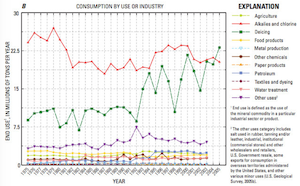
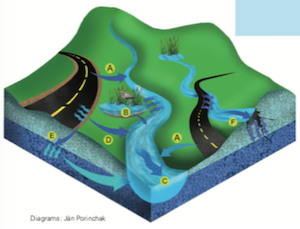
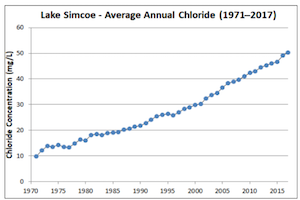
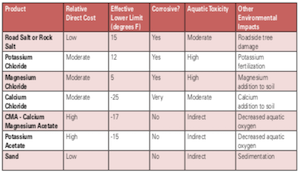
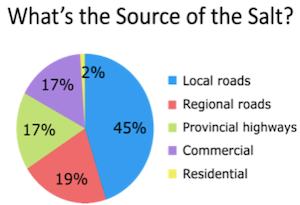
Bibliography
NH Department of Environmental Services. (2017). Environmental, Health and Economic Impacts of Road Salt. Retrieved from Programs, Bureaus and Units: NH Department of Environmental Services
Adams, I. (2019, February 07). A salty situation: road salt use in south Georgian Bay. Retrieved from Simcoe.com NEWS: https://www.simcoe.com/news-story/9155377-a-salty-situation-road-salt-use-in-south-georgian-bay/
American Physiological Society. (2018, OCTOBER 29). Plant-based ‘road salt’ good for highways but not for insects . Retrieved from © Phys.org: https://phys.org/news/2018-10-plant-based-road-salt-good-highways.html
Breining, G. (2017 , November 6). WE’RE POURING MILLIONS OF TONS OF SALT ON ROADS EACH WINTER. HERE’S WHY THAT’S A PROBLEM.Retrieved from Ensia: https://ensia.com/features/road-salt/
Canadian Wildlife Health Cooperative regional centre. (2018, 02 16). A Salt on Wildlife Health: The Environmental Impacts of Road Salt. Retrieved from Healthy Wildlife – Canadian Wildlife Health Cooperative regional centre.: http://blog.healthywildlife.ca/salt-wildlife-health-environmental-impacts-road-salt/
City of Toronto. (n.d.). Salt Management Plan. Retrieved from City of Toronto / Services & Payments / Streets, Parking & Transportation / Road Maintenance / Winter Road Maintenance / Salt Management Plan: https://www.toronto.ca/services-payments/streets-parking-transportation/road-maintenance/winter-maintenance/salt-management-plan/
Earth Innovations Inc. (2012). EcoTraction. Retrieved from Earth Innovations Inc.: http://www.ecotraction.com/productinfo.html
Hopper, T. (2018, January 22). How Canada’s addiction to road salt is ruining everything. Retrieved from National Post: https://nationalpost.com/news/canada/how-canadas-addiction-to-road-salt-is-ruining-everything
Kelly, V., Findlay, S., & Weathers, K. (2019). ROAD SALT: The Problem, The Solution, and How to Get There. Retrieved from Cary Institute of Ecosystem Studies: https://www.caryinstitute.org/sites/default/files/public/downloads/report_road_salt.pdf
Lake Simcoe Region Conservation Authority . (2016). Winter Salt . Retrieved from Lake Simcoe Region Conservation Authority : https://www.lsrca.on.ca/watershed-health/salt
Lake Simcoe Region Conservation Authority. (2012 ). Invasive Mussels. Retrieved from Lake Simcoe Region Conservation Authority: https://www.lsrca.on.ca/Shared%20Documents/newsletter/science-newsletter-vol2.pdf
MaxiSALT. (2017, January 28). Rock Salt Standards in the EU. Retrieved from MaxiSALT BLOG: http://www.erocksalt.com/rock-salt-standards-europe/
Minister of Public Works and Government Service. (2001). PRIORITY SUBSTANCES LIST ASSESSMENT REPORT: ROAD SALTS.Canadian Environmental Protection Act, 1999, Environment Canada Health Canada. Government of Canada.
Mohn, T. (2014, January 31). Salt + Winter Roads = Safety, A New Study Finds . Retrieved from Forbes Media: https://www.forbes.com/sites/tanyamohn/2014/01/31/salt-winter-roads-safety-a-new-study-finds-3/#20db5b113a35
Plumer, B. (2015, January 25). How America got addicted to road salt — and why it’s become a problem. Retrieved from Vox Media, Inc.: https://www.vox.com/2015/1/13/7531833/road-salt-environment-alternatives
Russell, A. (2017, January 11). Why do we still use road salt and what are the alternatives?Retrieved from Global News: https://globalnews.ca/news/3174300/why-do-we-still-use-road-salt-and-what-are-the-alternatives/
Simon, C. (2017, Apr 27). Community News. Retrieved from Simcoe.com: https://www.simcoe.com/community-story/7254989-salty-trend-may-cause-long-term-damage-to-lake-simcoe-watershed-lsrca/
Simon, C. (2018, 06 December). Busy year pushes Barrie’s winter maintenance work more than $900K over budget. Retrieved from Simcoe.com News: https://www.simcoe.com/news-story/9064860-busy-year-pushes-barrie-s-winter-maintenance-work-more-than-900k-over-budget/
Summers, J., & Valleau, R. (2019 , January 17). Road salt makes winter driving safer, but what does it do to the environment?Retrieved from The Conversation Academic rigour, journalistic flair: https://theconversation.com/road-salt-makes-winter-driving-safer-but-what-does-it-do-to-the-environment-87860
Tumilty, R. (2018, December 06). Rise in road salt prices hits local contractors. Retrieved from CBC NEWS: Ottawa: https://www.cbc.ca/news/canada/ottawa/ottawa-contractors-road-salt-price-hike-1.4934369
Whitehouse, J. (2018 , October 9). Spare some salt? The rock salt shortage of 2018. Retrieved from Landscape Ontario Horticultural Trades Association: https://horttrades.com/spare-some-salt-the-rock-salt-shortage-of-2018
